Abstract
Background:
Inula helenium was a perennial herb belonging to composite family and the roots of I. helenium have been widely used in traditional Chinese medicine. In this study, I. helenium was used as an experimental matrix.
Materials and Methods:
Ultrasound-assisted extraction (UAE) of total flavonoids from I. helenium was studied with dual wavelength UV-VIS spectrophotometer. Effects of various factors including ratio of material to liquid, ultrasonic time, ethanol concentration and extraction times on extraction yield of total flavonoids were evaluated. Then, orthogonal design of four factors at three levels was applied for optimization the extraction yields of flavonoids from the root of I. helenium.
Result:
The optimal extracting process of the total flavonoids from the root of the I. helenium was 1 g plant sample with 20 ml of 60% ethanol, extracting twice and each time for 20 min.
Conclusion:
Under these optimal conditions, the yield of total flavonoids was (17.36±0.94) mg/g. UAE was more efficient and time saving for the extraction of flavonoids from plant materials.
Keywords: Inula helenium, orthogonal design, total flavonoids, ultrasound-assisted extraction
INTRODUCTION
Inula helenium is a perennial composite plant and ranges throughout Asia, Europe, predominantly in Mediterranean region. The roots of I. helenium have been traditionally used as an expectorant, antitussive, diaphoresis and bactericidal agent in traditional Chinese medicine. Recently researches showed that it had various pharmacological activities such as antibacterial, antitumor, antiproliferative, anti-inflammatory, antistressor and antioxidant activities, etc.[1–4]
Exploring new bioactive compound from nature medicinal plants has become a hot spot. Extraction is the most important step in isolation and analysis of bioactive compounds from medicinal plants. Thus, it is essential to choose and optimize extraction conditions.
Ultrasound-assisted extraction (UAE), as an efficient extraction, was used for extraction of bioactive substances from plant because of improving extraction efficiency and shortening the time required. Recently, UAE had been widely for extraction of sesquiterpene,[5] flavonoids,[6] phenolics,[7] and polysaccharide,[8] etc.
Flavonoids are commonly contained in food and fruits and also considered to be an active ingredient in a number of medicinal herbs.[9] Some studies showed that flavonoids could protect against coronary heart disease,[10] membrane lipids from oxidation,[11] cancer or inhibit its development.
As far as we know, no reports of total flavonoids from I. helenium have been published. The aim of this study was to develop an UAE method and to measure the flavonoids with the use of UV-VIS spectrophotometer.
MATERIALS AND METHODS
Material and Instruments
The roots of I. helenium were purchased from the An Guo herbal material market, Hebei Province, China, and identified by Prof. Hengcheng Zhao (College of Traditional Chinese Medicine, Hebei North University). The specimens were kept in the Department of Pharmacy, Hebei North University. Rutin was obtained from the National Institutes for Food and Drug Control (batch number: 100080-200707). All the solvents and chemicals used in the experiments were analytical grade and purchased from Tianjin Beike Chemical Ltd., Co. (Tianjin).
Preparation of total flavonoids from I. helenium
Air-dried roots of I. helenium were ground and sifted through a 0.75-mm sieve. The process of flavonoids extraction from I. helenium was carried out in an ultrasonic cleaner JPCQ0628 (Jiapeng Electronics Co., Ltd, China). I. helenium powder (5.0 g) was mixed with solvent in a conical flask and sonicated (frequency 20 kHz, power 100 W) for different time (from 10 to 60 min) at 25°C, while the ratio of material to liquid ranged from 1:7 to 1:50. Flavonoids extraction was carried out according to experimental design. The extracts were centrifuged (15 min, 3000 rpm), then filtered through filter paper and analyzed for flavonoids content by UV-VIS spectrophotometer.
Procedures for the determination of total flavonoids
The yield of total flavonoids was determined with the aluminium nitrate methods of colorimetry. Two methods were used to quantify the content of flavonoids. (1) A total of 1 ml of each sample extraction was transfered into a 25-ml volumetric flask and mixed with 1.00 ml of the 5% (w/v) sodium nitrite for 6 min. Then, 1.00 ml of the 10% (w/v) aluminium nitrate solution was added and shaked up. After 6 min, 10 ml of the 4% (w/v) sodium hydroxide was added to it. The mixture was further diluted with ethanol solution up to 25 ml. The absorbance of the mixture against the blank solution was measured at 510 nm. The total flavonoids content was calculated and expressed as rutin equivalents. (2) Rutin standard solution (0.2 ml, 600.0 mg/l) was added to 1 ml each sample extraction. Other operations were performed as described previously. Rutin as an internal standard was used for the determination of flavonoids. The flavonoids content of sample was adjusted by internal standard.
Calibration and linearity
A total of 600.0 mg/l of the rutin standard solution was prepared by dissolving rutin reference material in ethanol solution. Rutin solution (0.2 ml, 0.4 ml, 0.6 ml, 1.0 ml, 1.5 ml) was accurately taken and put in 25-ml volumetric flasks, respectively. The following steps were similar to those sample treatment. The regression equation was A=0.0102 - 0.008(r=0.9996), with a good linearity in the range of 4.8-36 μg/ml.
Optimization of flavonoids extraction
An orthogonal design (L9(34)) was applied to evaluating the effects of the following influencing factors: ratio of material to liquid (A), ultrasonic time (B), ethanol concentration (C) and extract times (D). Nine extraction experiments were carried out in order to evaluate the best conditions for the extraction of flavonoids. Factors and levels test are displayed in Table 1. The data were analyzed using the SPSS statistical software (SPSS for windows, version 16.0; SPSS Inc.).
Table 1.
Factors and levels of the orthogonal design

Statistical analysis
All the experiments were performed in triplicate and the data were expressed as the mean ± SD (standard deviation). The results were analyzed by analysis of variance (ANOVA). The level of significant was set at P<0.05.
RESULTS AND DISCUSSION
Choice of methods for the determination of flavonoids from I. helenium
In this section, quantitation by the external standards method and internal standard method utilized for the estimation of flavonoids yield from I. helenium, respectively. By comparation, there was no statistically difference between these two methods (P<0.05). The external standards method has the advantage of not only convenient operation but also economy. Thus, the quantitative analysis of flavonoids was determined by external standard method.
Effect of ethanol concentration on total flavonoids yield
Five gram of fine powder was extracted with 50 ml of different concentration ethanol (20%, 30%, 40%, 50%, 60%, 80% and 95%) in ultrasonic bath at 25°C, respectively. All the time of ultrasonic was 30 min. The result was shown in Figure 1. It was noticed that the total flavonoids yield reached maximum when ethanol concentration was 50%, while either too high or too low degree will suppress the yield. This can be due to the fact that the total flavonoids in I. helenium were moderate polar components, and 50% ethanol may contribute to the extraction of flavonoids.
Figure 1.
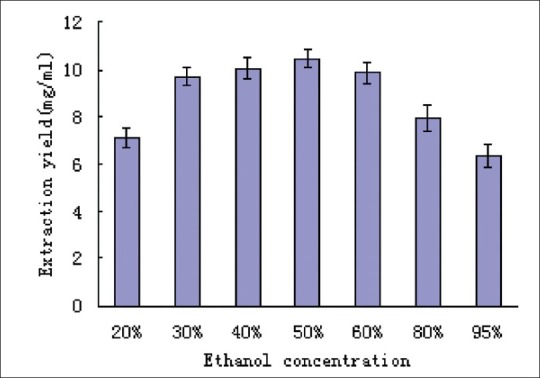
Effect of ethanol concentration on extraction yield (5g material mixed with ethanol solution at a material to solvent ratio of 1:10 was irradiated for 30 min under ultrasonic power of 100W)
Effect of ultrasonic time on total flavonoids yield
In order to get the maximum yield of flavonoids, different time of sonication (10, 20, 30, 40, 50, 60 min) was used in the experiment. Total flavonoids yield under different ultrasonic time are shown in Figure 2. The extraction yield of total flavonoids increased sharply within 30 min, but after 30 min, its yield had no difference. According to the Noyes-Whitney theory, the dissolution is fast at firstly, and changed little when the active ingredient concentration between inner and outer diffusion layer reach equilibrium after a period of extraction. Therefore, in the optimisation process, 30 min was chosen as the extraction time.
Figure 2.
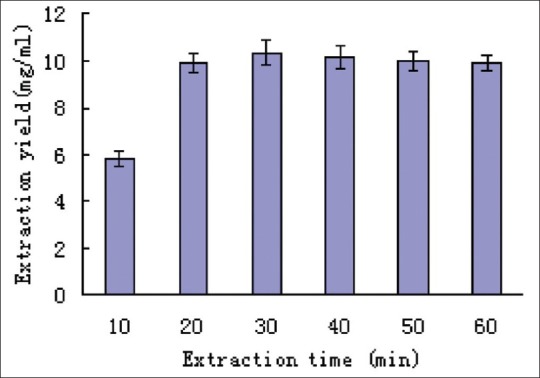
Effect of extraction time on extraction yield (5g material mixed with ethanol solution at a material to solvent ratio of 1:10 was irradiated under ultrasonic power of 100 W)
Effect of the ratio of material to liquid on total flavonoids yield
Solvent volume was another important factor for efficient extraction. In this work, effect of solid/solvent ratio on the flavonoids yield was investigated. First, other extraction conditions such as ethanol concentration, ultrasonic time, and number of extractions were fixed at 50%, 30 min, and only once, respectively, and the ratio of material to liquid was changed from 1:7 to 1:50. Figure 3 showed the results. It was found that the extraction yield of total flavonoids rose as the ratio of solvent to material is increased and reached maximum (13.62 mg/g) when the ratio was 20:1. However, there were few changes when the ratio improved. This meant that more time and energy were required to condense the extraction solution in later separation process. For this reason, the solid/ liquid ratio of 1:20 was suitable to reach the high yield of flavonoids.
Figure 3.
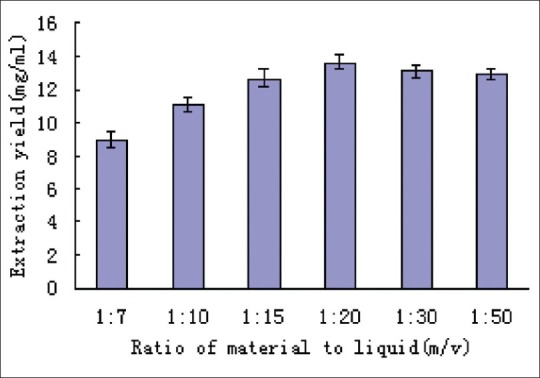
Effect of material to solvent ratio on extraction yield (5g material mixed with 50% ethanol solution was irradiated for 30 min under ultrasonic power of 100 W)
Effect of extract times on total flavonoids yield
The choice of number of extraction steps was also an important step. To determine the influence of number of extraction times on the yields of flavonoids, three groups of samples were extracted three times(3×30 min) under the above optimal conditions, that was, 50% ethanol, 30 min of ultrasonic time, and the ratio of material to solvent at 1:20. The results were displayed in Figure 4. The yield of flavonoids was 13.63 mg/g at the first extraction step, decrease at the second (3.09 mg/g) and became very low (only 0.48 mg/g) at the third step.
Figure 4.
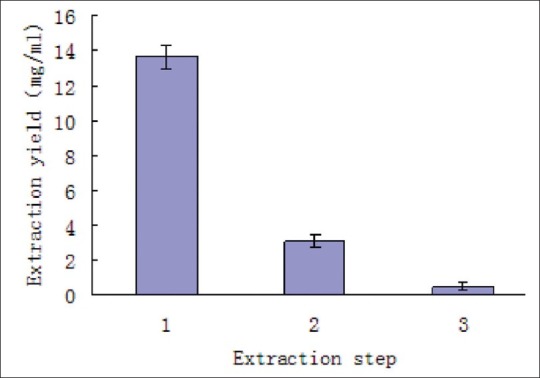
Effect of extraction step on extraction yield (5g material mixed with 50% ethanol solution at a material to solvent ratio of 1:20 was irradiated for 30 min under ultrasonic power of 100 W)
Optimization of the extraction condition of flavonoids from I. helenium
The experimental data obtained from orthogonal design were shown in Table 2 and analyzed by statistical method. The results suggested that there were great difference in the flavonoids yields between each experimental trail. From Table 2, it was seen that the influence factor to the extraction yields declined in sequential order: A>D>C>B. The analysis of variance (ANOVA) was performed and the results of ANOVA and F-test were seen in Table 3. From the Table 3, factor A (ratio of material to liquid) and D (extraction times) were statistically the significant at P<0.05, but no statistical difference were observed for other influence factors (ultrasonic time and ethanol concentration). The results demonstrated that the optimal conditions for extraction of flavonoids from I. helenium by UAE was A2D2C3B1, that was to say 20:1 of solvent/material ratio, twice extraction, 60% of ethanol concentration, and 20 minutes of ultrasonic time.
Table 2.
Orthogonal design and experimental results
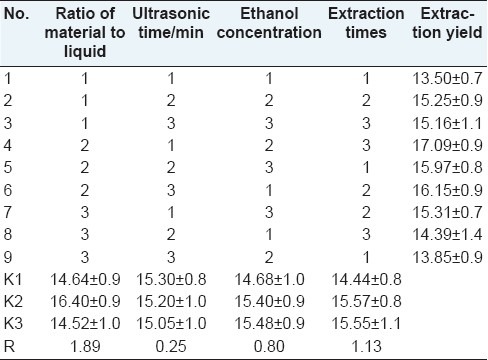
Table 3.
ANOVA analysis of four parameters for UAE
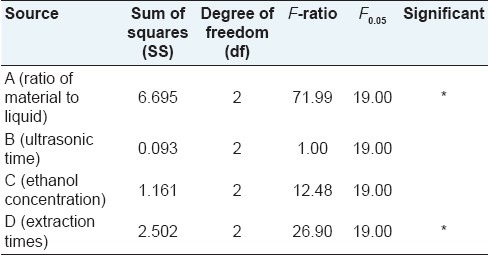
CONCLUSIONS
This paper was first attempted to evaluate the effects of four experimental factors, namely ratio of material to liquid, ultrasonic time, ethanol concentration and extraction times on the yields of total flavonoids from the root of I. helenium. Orthogonal design was used to optimize the extraction conditions. The results, seen from ANOVA, showed that ratio of material to liquid and extraction times played a critical role for achieving higher extraction yields. But other factors (Ultrasonic time and ethanol concentration) had secondary influence on the flavonoids yields. Under these optimal conditions, the yield of total flavonoids was (17.36±0.94) mg/g. UAE was more efficient and time-saving, especially suitable for thermosenstive compounds from plant materials. This study has done the preliminary research of the flavonoids from I. helenium, and the results are useful for the further utilization of I. helenium.
ACKNOWLEDGEMENT
The work was financially supported by the Hebei Administration of Traditional Chinese Medicine project (No. 2010046).
Footnotes
Source of Support: Grant from china, the Hebei Administration of Traditional Chinese Medicine project (No. 2010046)
Conflict of Interest: None declared.
REFERENCES
- 1.Deriu A, Zanetti S, Sechi LA, Marongiu B, Piras A, Porcedda S, et al. Antimicrobial activity of Inula helenium L. essential oil against Gram-positive and Gram-negative bacteria and Candida spp. Int J Antimicrob Agents. 2008;31:588–90. doi: 10.1016/j.ijantimicag.2008.02.006. [DOI] [PubMed] [Google Scholar]
- 2.Chaadaeva AV, Tenkeeva II, Moiseeva EV, Svirshchevskaia EV, Demushkin VP. Antitumor activity of the plant remedy peptide extract PE-PM in a new mouse T-lymphoma/eukemia model. Biomed Khim. 2009;55:81–8. [PubMed] [Google Scholar]
- 3.Konishi T, Shimada Y, Nagao T, Okabe H, Konoshima T. Antiproliferative sesquiterpene lactones from the roots of Inula helenium. Biol Pharm Bull. 2002;25:1370–2. doi: 10.1248/bpb.25.1370. [DOI] [PubMed] [Google Scholar]
- 4.Nesterova IuV, Zelenskaia KL, Vetoshkina TV, Aksinenko SG, Gorbacheva AV, Gorbatykh NA. Mechanisms of antistressor activity of Inula helenium preparations. Eksp Klin Farmakol. 2003;66:63–5. [PubMed] [Google Scholar]
- 5.Trendafilova A, Chanev C, Todorova M. Ultrasound-assisted extraction of alantolactone and isoalantolactone from Inula helenium roots. Pharmacogn Mag. 2010;6:234–7. doi: 10.4103/0973-1296.66942. [DOI] [PMC free article] [PubMed] [Google Scholar]
- 6.Yang L, Cao YL, Jiang JG, Lin QS, Chen J, Zhu L. Response surface optimization of ultrasound-assisted flavonoids extraction from the flower of Citrus aurantium L. var. amara Engl. J Sep Sci. 2010;33:1349–55. doi: 10.1002/jssc.200900776. [DOI] [PubMed] [Google Scholar]
- 7.Alipieva K, Petreska J, Gil-Izquierdo A, Stefova M, Evstatieva L, Bankova V. Influence of the extraction method on the yield of flavonoids and phenolics from Sideritis spp.(Pirin Mountain tea) Nat Prod Commun. 2010;5:51–4. [PubMed] [Google Scholar]
- 8.Zhong K, Wang Q, He Y, He X. Evaluation of radicals scavenging, immunity-modulatory and antitumor activities of longan polysaccharides with ultrasonic extraction on in S180 tumor mice models. Int J Biol Macromol. 2010;47:356–60. doi: 10.1016/j.ijbiomac.2010.05.022. [DOI] [PubMed] [Google Scholar]
- 9.Okuda T, Yoshida T, Hatano T. Pharmacologically active tanins isolated from medicinal plants. Basic Life Sci. 1992;59:539–69. doi: 10.1007/978-1-4615-3476-1_31. [DOI] [PubMed] [Google Scholar]
- 10.Boadi WY, Iyere PA, Adunyah SE. Effect of quercetin and genistein on copper- and iron-induced lipid peroxidation in methyl linolenate. J Appl Toxicol. 2003;23:363–9. doi: 10.1002/jat.933. [DOI] [PubMed] [Google Scholar]
- 11.Terao J, Piskula M, Yao Q. Protective effect of epicatechin, epicatechin gallate, and quercetin on lipid peroxidation in phospholipid bilayers. Arch Biochem Biophys. 1994;308:278–84. doi: 10.1006/abbi.1994.1039. [DOI] [PubMed] [Google Scholar]


